Abstract
Fling-step effect (static offset) besides forward directivity is one the major consequence of near-fault earthquakes. This effect may impose unanticipated seismic demands on structures. Comparing to forward directivity effect, few researches are concerned with the effect of fling-step. In this study, the contribution of fling-step effect on the elastic response spectra was examined by means of a probabilistic method as a new approach in investigation of fling-step effect. To this end, seismological parameters of a significant near-fault earthquake were obtained using inversion solution and MO-GA technique and then by randomly changing hypocenter of causative fault many ground motions were synthesized. Eventually, the influence and also the probable contribution of fling-step on the response spectra were achieved via probabilistic process.
1. Introduction
Distinct characteristics of near-field (near-fault) earthquakes with respect to those of far-field signify the special attention to such earthquakes. The accelerograms recorded near to ruptured fault contain two unique characteristics, (i). Rupture directivity (large velocity pulse) and (ii). Large co-seismic displacement (also known as permanent static displacement or fling-step). Landers-USA (1992), Kocaeli-Turkey (1999), Chi-chi-Taiwan (1999) are the most famous near-filed earthquakes having the two mentioned characteristics. Earthquakes coupled with directivity effect impose extreme demands on structures and are recognized to have caused drastic damage in previous near-fault earthquakes [1]. Such near-fault consequents will cause the greater part of the seismic energy from the rupture to reach a single coherent long-period pulse of motion. Valuable investigations have been performed by some researchers [1-6]. The majority of investigations are generally focused on rupture directivity and fewer studies are concentrated on fling-step effect. Therefore, the need to further investigations on fling-step effect seems necessary [4].
The effects of rupture directivity are generally considered by modifications to the elastic response spectra (5 % damping ratio) in current design codes [3, 7-9]. In this study the focus is on investigating the effect of fling-step on the response spectra using probabilistic approach. To this end, seismological parameters of Kocaeli Earthquake (a distinct sample of near-fault earthquake) were achieved using inversion solution, evolutionary approach (MO-GA) and Theoretical-based Green’s Function (TGF) method with regard to desired objectives (Permanent displacement, response spectra and multitaper spectra [7, 10]). This methodology was previously introduced by the authors for compatible seismogram simulation [7]. Afterwards, by changing the hypocenter location, many new waveforms were generated and the distinguishing ones having considerable fling-step were chosen for probabilistic operations. By extracting fling-step signal from the primary waveforms using a special technique, the effect of fling-step on the response spectra was investigated.
2. Near-field charactersirics and simulation procedure
Ground motions near to ruptured fault are meaningfully different from those observed further away from the active fault. These motions come with long-period pulses which reveal two major effects; fling-step and rupture directivity (forward directivity). These effects may impose sever structural damages on structures [8, 11, 12]. The specific characteristics of such long-period ground motions are the interest of many researchers. The limited numbers of near-fault earthquake demonstrate the shortcoming of such earthquakes in the process of concerned studies. Therefore, lack of recorded ground motions at stations near the ruptured fault reveals the need to overcome this problem by simulating synthetic ground motions. Modeling and simulating ground motions are also the interest of other researchers and those can be useful for seismic analyses [13, 14]. The simulation procedure should be as much as similar to the nature of faulting; hence finding the seismological parameters of an existing near-fault earthquake is of high importance. Among several approaches in the literature for retrieving near-fault ground motion e. g. omega-squared methods, semi empirical-based methods, theoretical green’s function-based methods and hybrid methods [3, 15-19], the theoretical green’s function (TGF) method due to its capability to model both fling-step and rupture directivity was adopted to simulate the desired ground motions [20]. Using inversion solution, Multi-Objective Genetic Algorithm (MO-GA) and TGF method at 0-1.5 Hz frequency, seismological parameters of Kocaeli (1999) Earthquake were achieved via a computer code written in MATLAB [21]. For more details about GA technique and inverse problem, please see the research done by Jimenez [22]; and Royzman and Goroshko [23]. The upper-lower bounds of parameters were adopted from the previous studies [24, 25]. The proposed Fitness Function (FF) used in this code is defined as the inverse of Error Function (EF) expressed as Eq. 1:
where refers to the objective parameters (: response spectra, : multitaper spectra, : permanent displacement), and are recorded and synthesized seismograms and denotes vector dimension. Table 1 shows the achieved seismological parameters of Kocaeli EQ.
Table 1Achieved seismological parameters of Kocaeli EQ using MO-GA
Longitude (deg) | Latitude (deg) | Depth (km) | Focal mechanism (strike, dip and rake) | Rupture length (km) | Rupture width (km) | Rupture velocity (m/s) | Slip (m) |
29.97 | 40.7 | 16.5 | 91.04, 89.88, 170 | 100 | 20 | 2500 | var |
Having the seismological parameters in hand and changing the location of hypocenter as a random parameter, many waveforms were generated at YPT station (see Figure 1).
Fig. 1Changing the location of hypocenter at causative fault for generating new waveforms

3. Fling-step recognition and extraction
Fling-step which is related to permanent tectonic displacement near the causative faults, leads to one-sided velocity pulse and consequently to two-sided acceleration pulse (integration of velocity pulse). The concerned equation of two-sided acceleration pulse is written in the form of Eq. 2 [1]. By forming the mentioned diagrams and equation, the fling-signal can be extracted from the initial acceleration (waveform). Figure 2 displays the fling-step signal and corresponding velocity and displacement diagrams.
Fig. 2The fling-step pulse as an acceleration and corresponding velocity and displacement

where is variable of time, is the permanent displacement (maximum amplitude of the displacement), is the period of sinusoidal pulse and is the pulse arrival time. To display the aforementioned technique, the displacement, the acceleration and the corresponding response spectra for a waveform before and after the removal of fling-step signal are shown in Figure 3.
Fig. 3Effect of fling-step signal on response spectra (red: with-fling; black: without-fling)
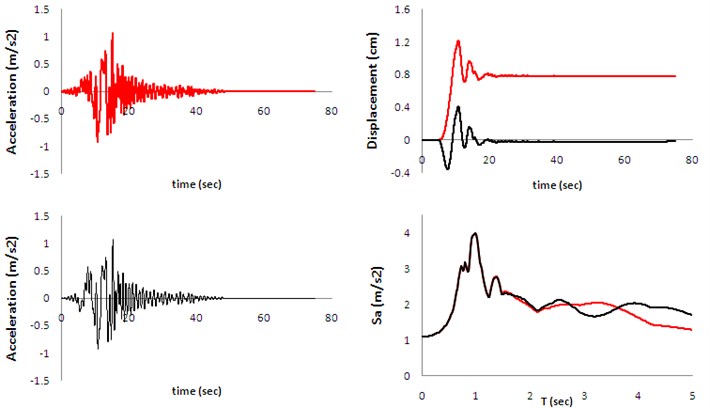
The figure demonstrates that removing the fling signal (fling-step effect) from the primary acceleration may increase or decrease the value of response spectra () regarding the amount of period (). This implies that with respect to fundamental period of structure, fling-step effect may decrease or increase the imposed seismic demands.
4. Data analysis and results
The abovementioned procedures and techniques were implemented to the selected accelerograms to gain the goal of investigating the effect of fling-step on the response spectra. The methodology is described concisely in the following flowchart (Figure 4).
Fig. 4Flowchart of applied procedure
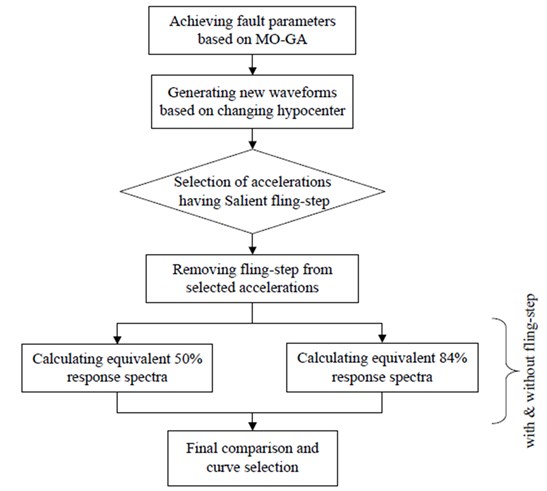
The total number of 32 ground motions (waveforms) having significant fling-step were selected among the 567 synthesized ones and the expressed procedure was applied to them. The fling-step signals were recognized visually via the displacement diagrams and they were extracted from the primary waveforms using supplied computer code. The waveforms, the fling-step signals, the displacement diagram and the concerned response spectra are demonstrated in Figures 5-7.
Fig. 5Selected ground motions: (a) with fling-step and (b) without fling-step signal
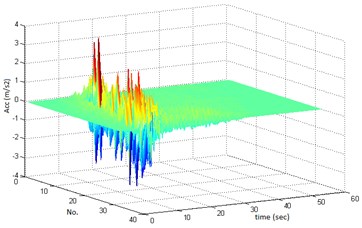
(a)
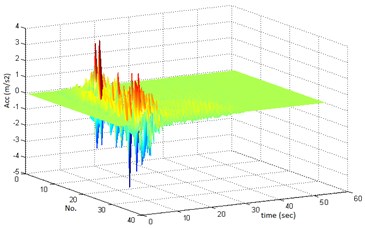
(b)
Fig. 6The extracted fling-step signals: (a), and the corresponding displacements (b)
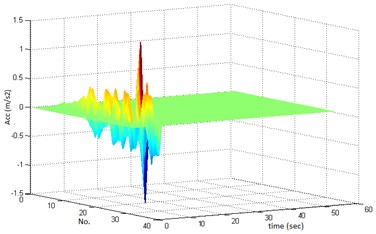
(a)
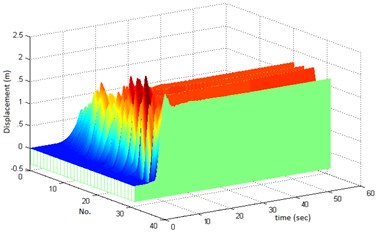
(b)
Fig. 7Response spectra: (a) with fling-step and (b) without fling-step signal
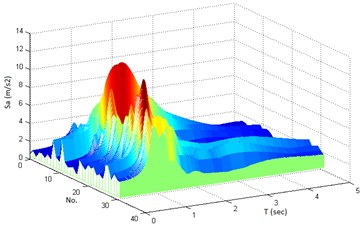
(a)
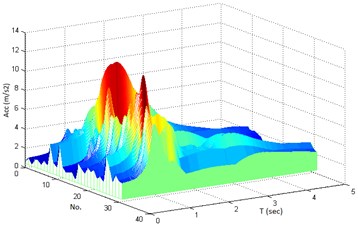
(b)
In the following, a very important class of statistical distributions named “normal distribution” is used to perform the probabilistic process. Normal distribution curve is symmetric and has “bell-shaped” density curve having a single peak. Since it approximates many natural phenomena so well, this distribution has developed into a typical reference for many probability problems [26]. The two major quantities of this distribution (mean) and (standard deviation) were calculated for each set of data (response spectra; with and without fling-step effect) via a computer code written in MATLAB. The closest existing spectra (having minimum error) to the curves corresponding to probability of 50 % () and 84 % () were achieved. Figure 8 demonstrates the comparison of the response spectra in two statuses, with and without fling-step effect. The left diagram is related to the probability of 50 % and the right one is related to 84 %. The difference between the response spectra with and without fling-step is visible for Periods () more than 1.7 sec.
Fig. 8Response spectra (wf: with fling; wof: without fling)
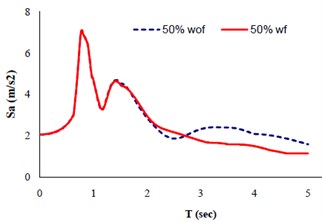
(a)
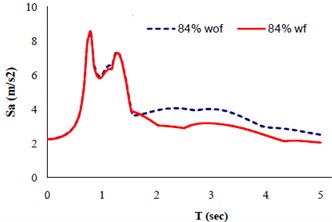
(b)
The Fast Fourier Transform (FFT) of the accelerations (concerning the response spectra shown in Figure 8) is carried out and demonstrated in Figure 9. The difference between the FFT Amplitudes in low frequency range (long period) can justify the difference between the response spectra at Figure 8.
Fig. 9FFT comparison (wf: with fling; wof: without fling)
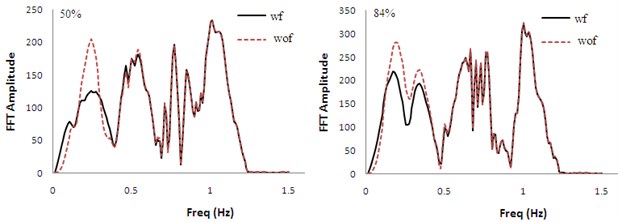
The displacements and the corresponding accelerations for each case (50 % and 84 %) are shown in Figure 10. They show the fling-step (permanent displacement) occurring at site for expected probability and the corresponding accelerations could be used as the input of dynamic analysis. Also, one can develop his own risk and probability to achieve the desired curves.
Fig. 10Acceleration (ground motion) and displacement corresponding to achieved response spectra
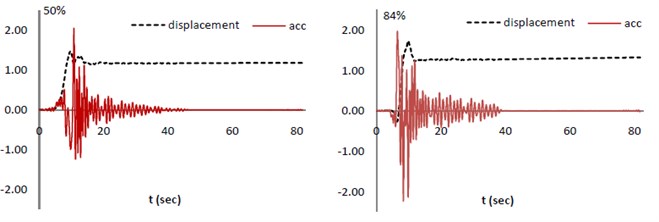
5. Conclusion
By incorporating the inversion solution technique, evolutionary approach, engineering seismology, probabilistic method and earthquake engineering, the probable contribution of fling-step was studied. The results imply that the existence of fling-step in ground motions can mostly decrease the value of response spectra, while it can also act adversely (please see Figure 8, left one, 2.4 sec). That is why the word “unanticipated” was used in the beginning of this study for describing the effect of fling-step. A new approach was also introduced that provides a technique taking the account of probability in fling-step investigations. Accordingly, one can determine the amount of the desired safety and choose the probability index (, , , etc.) and consequently find the corresponding accelerograms for analysis. The results and techniques of this study could be useful for designing and retrofitting of structures at near source sites with respect to the desired risk or safety.
References
-
Kalkan E., Kunnath S. K. Effects of fling step and forward directivity on seismic response of buildings. Earthquake Spectra, Vol. 22, Issue 2, 2006, p. 367-390.
-
Alavi B., Krawinkler H. Consideration of near-fault ground motion effects in seismic design. Proceedings 12th World Conference on Earthquake Engineering, New Zealand, 2000.
-
Somerville P. G. Magnitude scaling of the near fault rupture directivity pulse. Physics of the earth and planetary interiors, Vol. 137, 2003, p. 201-212.
-
Lestuzzi P., Schwab P., Koller M., Lacave C. How to choose earthquake recordings for nonlinear seismic analysis of structures. 13WCEE, Vol. 1241, 2004.
-
Gillie J. J., Rodriguez-Marek A., McDaniel C. Strength reduction factors for near-fault forward-directivity ground motions. Engineering Structures, Vol. 32, Issue 1, 2010, p. 273-285.
-
Nicknam A., Hosseini A., Hamidi Jamnani H., Barkhordari M. A. Investigation of fling-step effect on the selected structures subjected to the simulated Fandoqa near-source strong motion. Journal of Vibroengineering, Vol. 16, Issue 1, 2013.
-
Nicknam A., Barkhordari M. A., Hamidi Jamnani H., Hosseini A. Compatible seismogram simulation at near source site using multi-taper spectral analysis approach. Journal of Vibroengineering, Vol. 15, Issue 2, 2013, p. 626-638.
-
Somerville P. G., Smith N. F., Graves R. W., Abrahamson N. A. Modification of empirical strong ground motion attenuation relations to include the amplitude and duration effects of rupture directivity. Seism. Res. Lett. 68, 1997, p. 199-222.
-
ASCE-7-10. Minimum Design Loads for Buildings and Other Structures. American Society of Civil Engineers, 2010.
-
Hamidi Jamnani H., Hosseini A., Issa M. A., Nicknam A. Seismic structural performance using theoretical-based synthetic waveform with respect to the site soil conditions. 2nd International Conference on Performance-Based Design in Earthquake Geotechnical Engineering, Italy, 2012.
-
Lili X., Longjun X., Rodriguez-Marek A. Representation of near-fault pulse-type ground motions. Earthquake Engineering and Engineering Vibration, Vol. 4, Issue 2, 2005, p. 191-199.
-
Bray J. D., Rodriguez-Marek A. Characterization of forward-directivity ground motions in the near-fault region. Soil Dynamics & Earthquake Eng., Vol. 24, 2004, p. 815-828.
-
Šliaupa S. Modeling of the ground motion of the maximum probable earthquake and its impact on buildings. Journal of Vibroengineering, Vol. 15, Issue 2, 2013, p. 532-543.
-
Wei B., Cui R., Dai G. Seismic performance of a rolling-damper isolation system. Journal of Vibroengineering, Vol. 15, Issue 3, 2013, p. 1504-1512.
-
Nicknam A., Eslamian Y. A hybrid method for simulating near-source, broadband seismograms. Application to the 2003 Bam earthquake. Tectonophysics, Vol. 487, 2010, p. 46-58.
-
Bouchon M. A simple method to calculate green’s functions for elastic layered media. Bulletin of the Seismology Society of America, Vol. 71, Issue 4, 1981, p. 959-971.
-
Koketsu K. Miyake H. A seismological overview of long-period ground motion. J. Seismol., Vol. 12, 2008, p. 133-143.
-
Pitarka A., K. Irikura, T. Iwata, H. Sekiguchi Three-dimensional simulation of the near-fault ground motion for the 1995 Hyogoken Nanbu (Kobe), Japan earthquake. Bull. Seism. Soc. Am., Vol. 88, 1998, p. 428-440.
-
Mai P. M., Beroza G. C. A hybrid method for calculating near-source, broadband seismograms: Application to strong motion prediction. Phys. Earth Planet. Int., Vol. 137, Issue 1-4, 2003, p. 183-199.
-
Hisada Y., Bielak J. A Theoretical method for computing near-fault ground motions in layered half-spaces considering static offset due to surface faulting, with a physical interpretation of fling step and rupture directivity. Bulletin of the Seismological Society of America, Vol. 90, Issue 2, 2003, p. 387-400.
-
Hamidi Jamnani H., Nicknam A., Hosseini A., Barkhordari M. A. Simulation of long-period TGF ground motions having fling-step for structural performance study. KSCE Journal of Civil Engineering, Paper in review, 2012.
-
Jimenez A., Garcia M. J., Romacho M. D. Simultaneous inversion of source parameters and attenuation factor using genetic algorithm. Bull. Seism. Soc. Am., Vol. 95, Issue 4, 2005, p. 1401-1411.
-
Royzman V., Goroshko A. Multiple inverse problem. Journal of Vibroengineering, Vol. 14, Issue 3, 2012, p. 1417-1424.
-
Yagi Y., Kikuchi M. Source rupture process of the Kocaeli, Turkey, earthquake of August 17, 1999, obtained by joint inversion of near-field data and teleseismic data. Geophysical Research Letters, Vol. 27, Issue 13, 2000, p. 1969-1972.
-
Sekiguchi H., Iwata T. Rupture process of the 1999 Kocaeli, Turkey, earthquake estimated from strong-motion waveforms. Bulletin of the Seismological Society of America, Vol. 92, Issue 1, 2002, p. 300-311.
-
Bryc Wlodzimierz. The normal distribution: characterizations with applications. Springer-Verlag, ISBN 0-387-97990-5, 1995.
